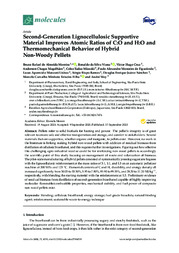Second-generation lignocellulosic supportive material improves atomic ratios of C:O and H:O and thermomechanical behavior of hybrid non-woody pellets.
Second-generation lignocellulosic supportive material improves atomic ratios of C:O and H:O and thermomechanical behavior of hybrid non-woody pellets.
Author(s): MOREIRA, B. R. de A.; VIANA, R. da S.; CRUZ, V. H.; MAGALHÃES, A. C.; MIASAKI, C. T.; FIGUEIREDO, P. A. M. de; LISBOA, L. A. M.; RAMOS, S. B.; JUÁREZ SÁNCHEZ, D. E.; TEIXEIRA FILHO, M. C. M.; MAY, A.
Summary: Abstract: Pellets refer to solid biofuels for heating and power. The pellet's integrity is of great relevant to ensure safe and effective transportation and storage, and comfort to stakeholders. Several materials that are supportive, whether organic and inorganic, to pellets exist. However, no work in the literature is linking making hybrid non-wood pellets with addition of residual biomass from distillation of cellulosic bioethanol, and this requires further investigations. Figuring out how effective this challenging agro-industrial residue could be for reinforcing non-wood pellets is accordingly the scientific point of this study focusing on management of waste and valorization of biomass. The pilot-scale manufacturing of hybrid pellets consisted of systematically pressing sugarcane bagasse with the lignocellulosic reinforcement at the mass ratios of 3:1, 1:1, and 1:3 on an automatic pelletizer machine at 200 MPa and 125 °C. Elemental contents of C and H, durability, and energy density all increased significantly from 50.05 to 53.50%, 5.95 to 7.80%, 95.90 to 99.55%, and 28.20 to 31.20 MJ kg-1, respectively, with blending the starting material with the reinforcement at 1:3. Preliminary evidence of residual biomass from distillation of second-generation bioethanol capable of highly improving molecular flammable/combustible properties, mechanical stability, and fuel power of composite non-wood pellets exist.
Publication year: 2020
Types of publication: Journal article
Unit: Embrapa Environment
Observation
Some of Embrapa's publications are published as ePub files. To read them, use or download one of the following free software options to your computer or mobile device. Android: Google Play Books; IOS: iBooks; Windows and Linux: Calibre.
Access other publications
Access the Agricultural Research Database (BDPA) to consult Embrapa's full library collection and records.
Visit Embrapa Bookstore to purchase books and other publications sold by Embrapa.

